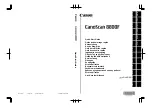
19
6. Adjust
VOLUME
to a comfortable
level.
7. Slowly turn
SQUELCH
clockwise
until the hissing noise stops.
Squelch Tips:
• If the scanner picks up
unwanted or weak transmis-
sions, slightly turn
SQUELCH
clockwise to decrease receiver
sensitivity.
• If the scanner does not pick up
any transmissions, slightly turn
SQUELCH
counterclockwise to
increase receiver sensitivity.
FINDING BIRDIE
FREQUENCIES
Birdies are operating frequencies
generated and used inside the scan-
ner’s receiver. These operating fre-
quencies could interfere with
broadcasts on the same frequencies
and make them difficult or impossible
to receive.
These are the most common birdies
to watch for:
31.0500 MHz
134.550 MHz
127.2500 MHz
136.050 MHz
128.1875 MHz
138.050 MHz
128.2500 MHz
140.275 MHz
129.6875 MHz
144.900 MHz
132.0500 MHz
171.250 MHz
132.2625 MHz
If you store one of these frequencies
into a channel, you might hear only
noise when the scanner stops on that
frequency. If the interference is not
severe, you might be able to turn
SQUELCH
clockwise to cut out the
birdie.
To find your scanner’s specific bird-
ies:
1. Disconnect the antenna and
move it away from the scanner.
Note: Make sure that no other
nearby radios or TVs are turned
on.
2. Search every frequency band
from its lowest frequency to the
highest (see “Searching For and
Temporarily Storing Active Fre-
quencies”).
If searching stops (as if the scanner
had found a signal) but there is no
sound, that frequency might be a
birdie.
For future reference, record all the
birdies in your particular scanner.
20-414.fm Page 19 Wednesday, August 4, 1999 11:12 AM
















































